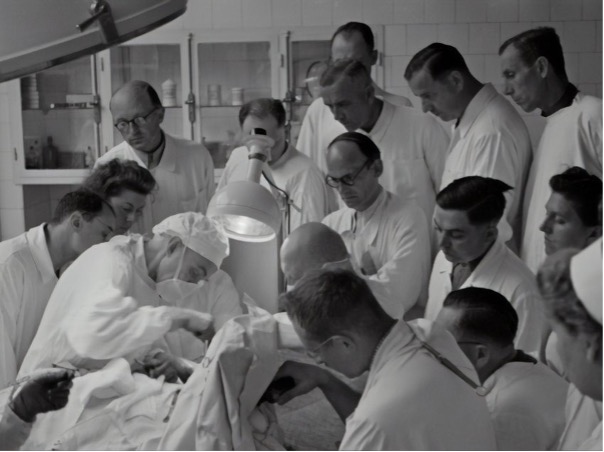First published in the NASGP Newsletter 18th April 2022

In the early 1960s Dr Kildare represented everyone’s ideal doctor, earnestly navigating clinical and moral dilemmas under the guidance of his mentor Dr Gillespie. Not every episode had a happy ending, but good-looking Dr Kildare always ended up the wiser. And there were attempts to reflect the real world. President Lyndon B. Johnson actually requested that the series feature the growing social problem of venereal disease, but the network funked the challenge.
Since Dr Kildare, medical serials have been a TV staple, most memorably ER, written by former doctor and author of Jurassic Park, Michael Crichton. Though it might be difficult for many viewers to take their eyes off George Clooney, ER, unlike Dr Kildare, was essentially about the whole team, a formula followed in Britain by Casualty and Holby City. African-American and woman doctors joined the cast. Over its 15-year life ER introduced its huge audience to issues such as AIDS and even ventured to Iraq. But it has dated – all those women with glamourous hair, all those wisecracks and soap-opera personal lives.
Running alongside fictional medical shows was a programme about real life surgeons and their patients. Your Life in Their Hands started in 1958 – before the Dr Kildare era – and continued for several decades. Jonathan Miller and Robert Winston were among the medics who presented it. A doctor from the Lancet provided advice, but the BMA huffed and puffed about doctors being dragged off their pedestals until the programme’s popularity led them to review their position.
It upset some senior doctors, but in the 1980s ‘The House of God’ was the go-to book for exhausted junior doctors who needed to let off steam. Although the author, Samuel Shem, was a psychiatrist and worked in New York, the lives of his characters resonated with young British doctors. Irreverent terms like ‘turf’ and the ‘O/Q conversion’ and ‘transferred to Floor 10’ (of a nine-floor hospital) became common currency.
Home-grown cynicism exploded in print and then on screen with Jed Mercurio in the 1990s. He vividly described how his medical student’s idealism was quickly destroyed once he started working on the wards, and how he sought solace in an awful lot of vividly described sex. His medical shows have won plaudits even from doctors, despite their unflinching representations of negligence, the closing of the ranks to protect colleagues and the treatment meted out those who dare to blow the whistle. He quit to write mega-successes like Line of Duty.
The most recent scream of pain comes from Adam Kay. I read This Is Going to Hurt when it first came out in 2017. I could identify the reality of Kay’s experiences and respond to his plea for the NHS in his final chapter. In 2018 his show sold out at the Edinburgh Fringe and it has come back several times to the Garrick Theatre in London. Unfortunately, in a large Victorian theatre stand-up falls down. What I saw was an ill-dressed performer. What I heard was curiosities-yanked-out-of-orifices anecdotes and crude medical school panto songs. After that, I wonder whether his lay audiences could absorb his final impassioned plea.
Non-medical friends stopped watching because they felt it couldn’t be realistic.
Now there is his seven-part adaptation of ‘This Is Going to Hurt’. It packs a punch. Non-medical friends stopped watching because they felt it couldn’t be realistic. It is compressed, I explained, but nothing was portrayed that hasn’t happened to Kay. It follows the book quite closely – and the exhaustion, the weight of too much responsibility and the stress of understaffing is sadly familiar to most of us. I wondered how the show would represent the chaos of out-patient clinics. It’s brilliantly done with a succession of quick shots: yet another pile of patients’ notes dumped on the junior doctor’s desk, patients endlessly streaming in and out, moments snatched to grab a bite to eat and lunch eventually consigned to the bin. And I was delighted that one episode dramatically demonstrated why, when something goes awry, gourmet meals and Monet reproductions in a private hospital are no substitute for an ITU.
We may hurt with Kay or be angered that he passes on how he is treated to Shruti, his junior, and we feel for her as she struggles to live up to her ideals and her parents’ hopes. Our own failures, too, gnaw away at us. Many medics will recognise the difficulty of sharing their experiences with a partner, let alone friends.
This Is Going to Hurt vividly illustrates the heavy price doctors and their colleagues pay to keep the NHS show on the road. It has made a lot of viewers think again. But I have seen no sign that the intended recipient has read Kay’s Open Letter to the Secretary of State for Health at the end of his book, or has taken on board the messages of ‘This Is Going to Hurt’. Maybe, if he sees the show at all, he chooses to believe it is fiction. In which case I recommend that he read psychologist Caroline Elton’s book ‘Also Human: The Inner Lives of Doctors’. She presents case studies of doctors who have reached a crisis in their professional lives. It is a painful read, and it was published 18 months before the pandemic made the pressures on doctors so much worse.
Hopefully, services like Prof Clare Gerada’s Doctors in Distress mean that fewer doctors are committing suicide or dropping out of medicine. But young doctors reaching the point of taking their own lives is an appalling indictment of the system in which they work. All of us need to find moments to look after ourselves, and having done so, to shout to the government and the leaders of the NHS that they owe a duty of care to those whom they expect to care for others.